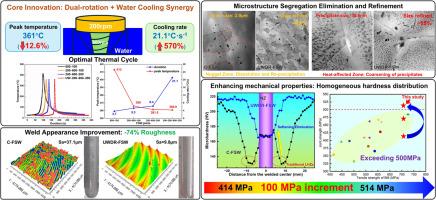Inhibiting microstructure segregation and softening in a 700 MPa grade Al-Zn-Mg-Cu alloy by a novel underwater-assisted dual-rotation friction stir welding method
IF 14.3
1区 材料科学
Q1 MATERIALS SCIENCE, MULTIDISCIPLINARY
引用次数: 0
Abstract
700 MPa grade ultra-high strength Al-Zn-Mg-Cu alloys containing over 10 wt.% Zn exhibit significant potential in lightweight materials design, but its weldability remains a major obstacle in practical applications, even employing solid-state friction stir welding (FSW). The substantial increase in Zn content not only reduces the material's plastic deformation capability but also promotes distinct microstructural segregation during FSW. Here, we report superior weld appearance and enhanced joint strength achieved in a 700 MPa grade Al-Zn-Mg-Cu alloy using an innovative underwater-assisted dual-rotation friction stir welding (UWDR-FSW) method. Excellent weld appearance and homogeneous microstructure were obtained by applying an extremely low shoulder rotation rate of 200 rpm combined with water cooling due to the elimination of overheating. High solute solubility and fine recrystallization grains improve the microhardness values of the nugget zone (NZ). Conversely, the dramatically reduced peak temperature and increased cooling rate suppressed precipitate coarsening in the heat-affected zone (HAZ), resulting in a higher microhardness value than even that of the NZ. This new UWDR-FSW process successfully eliminated the microstructural segregation and traditional low-hardness zones in the HAZ, significantly improving joint strength to 514 MPa compared to the conventional FSW joint (414 MPa). This work contributes a novel approach for welding ultra-high-strength aluminum alloys with high alloying content, supported by comprehensive experimental data and theoretical analysis.

水下辅助双旋转搅拌摩擦焊抑制700 MPa级Al-Zn-Mg-Cu合金组织偏析和软化
700mpa级的超高强度Al-Zn-Mg-Cu合金在轻量化材料设计中具有巨大的潜力,但其可焊性仍然是实际应用中的主要障碍,即使采用固态搅拌摩擦焊(FSW)。锌含量的大幅增加不仅降低了材料的塑性变形能力,而且在搅拌变形过程中促进了明显的组织偏析。在这里,我们报告了采用创新的水下辅助双旋转搅拌摩擦焊接(UWDR-FSW)方法,在700 MPa级Al-Zn-Mg-Cu合金中获得了优异的焊缝外观和增强的接头强度。采用极低的200转/分肩转速并结合水冷却以消除过热,获得了优异的焊缝外观和均匀的微观结构。高溶质溶解度和细小的再结晶晶粒提高了熔核区的显微硬度值。相反,峰值温度的显著降低和冷却速率的增加抑制了热影响区(HAZ)析出相的粗化,导致显微硬度值甚至高于NZ。这种新的UWDR-FSW工艺成功地消除了HAZ内的显微组织偏析和传统的低硬度区,与传统的FSW接头(414 MPa)相比,接头强度显著提高到514 MPa。本工作为高合金含量超高强铝合金的焊接提供了新的途径,并得到了全面的实验数据和理论分析的支持。
本文章由计算机程序翻译,如有差异,请以英文原文为准。
求助全文
约1分钟内获得全文
求助全文
来源期刊

Journal of Materials Science & Technology
工程技术-材料科学:综合
CiteScore
20.00
自引率
11.00%
发文量
995
审稿时长
13 days
期刊介绍:
Journal of Materials Science & Technology strives to promote global collaboration in the field of materials science and technology. It primarily publishes original research papers, invited review articles, letters, research notes, and summaries of scientific achievements. The journal covers a wide range of materials science and technology topics, including metallic materials, inorganic nonmetallic materials, and composite materials.
 求助内容:
求助内容: 应助结果提醒方式:
应助结果提醒方式:


